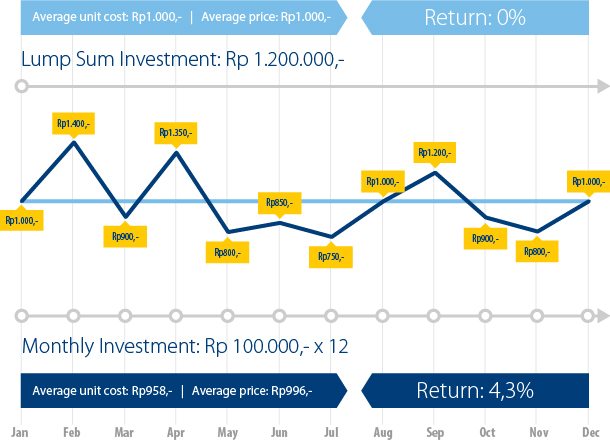18
Dollar Cost Averaging
Many people are “afraid” to invest because they are not ready to face the risks and the fluctuating market. Furthermore, many consider themselves unprepared because they feel they lack investment knowledge. In truth, investment can be easily understood and carried out. One of the ways to do this is by conducting periodical investments, known as the Dollar Cost Averaging concept. By investing periodically, we can minimize investment risks due to uncertain market movement. How? Below are the illustrations:
You allocate Rp100,000 per month for investing in a mutual fund. When your Net Asset Value per Unit (NAV/Unit) increases in the next month, you continue to invest Rp100,000 that month, which will result in fewer mutual fund units. On the contrary, if the NAV/Unit declines in the next two months and you continue to invest Rp100,000, you will get more units. With patience and continuous investment of Rp100,000 per month for one year, without being affected by the fluctuations of mutual funds’ NAV/Unit in the market, your average purchase price of the mutual fund units will be lower than the average unit price in that period.

The illustration above indicates that market price will always fluctuate and cannot be accurately predicted, which affects the mutual fund NAV/Unit. Many people make the mistake of going with the current by increasing their investment funds when the NAV/Unit is rising and panicking when it is declining, leading to them selling their units. Meanwhile, the key of investment is the discipline in investing according to the allocated fund without being affected by the market’s condition and flow. Warren Buffet once advised: “Investors should remember that excitement and expenses are their enemies. And if they insist on trying to time their participation in equities, they should try to be fearful when others are greedy and greedy only when others are fearful.”
In general, the Composite Index of a country tends to show positive movement in the long term. In Indonesia for instance, did you know that the JCI in 2002,was at 424.95 and was closed at 4,316.69 in 2012? If you had invested in the JCI during that 10-year period, the yield would have reached 916% or 91.6% per year, despite the fact that the JCI dropped 50.6 percent in 2008.
The positive JCI movement in the long term is usually driven by the positive performance of the companies included in the JCI, due to national economic growth.
As an example, when a country’s economy is growing, the citizens’ income and welfare are also improving. This will result in increased demand for products and services. For example, for a company that makes toothpaste, citizens’ income and population growth will boost demand for its toothpaste products. The company will then respond to the growing demands by increasing its production capacity or introducing new variants at higher prices. What does it mean? Of course it will lead to increased product sales and company’s profit, which will boost the company’s share price, following the company’s positive performance. If several companies are experiencing positive growth in their performance, the stock exchange where those companies are listed will also see positive moves. So, commit to long-term investments regularly to avoid unfortunate timing or unfavorable investment climate.
After learning about the Dollar Cost Averaging concept, we hope you who have started investing are getting more enthusiastic, and those of you who have yet to start investing can soon begin. For those who count on monthly salaries, holiday bonuses, and bonuses, this concept is easier to apply because we only have to discipline ourselves in allocating money into a fixed investment fund taken off of our monthly salary. If we apply the concept in a long-term period, we will be able to meet our future needs early. Let it snowball from something small into something great. Prove it with periodic investment!



